HND Health & Social Care: Unit 4 Personal & Professional Development
VerifiedAdded on 2024/06/03
|24
|4385
|305
Report
AI Summary
This report delves into the personal and professional development of individuals within the health and social care sector. It emphasizes the importance of balancing personal values with professional responsibilities, highlighting how cultural experiences, ethical considerations, and legal policies influence the workplace environment. The report explores various learning styles, including activist, reflector, theorist, and pragmatist approaches, and employs SWOT analysis as a tool for self-assessment. A holistic personal development plan is presented, outlining strategies and timelines for achieving specific goals related to managing work pressure, maintaining healthy relationships, and improving communication skills. The report further discusses practices for overcoming barriers to performance, such as monitoring progress and conducting skill assessments. The overall aim is to enhance individual capabilities and contribute to a more effective and supportive work environment within health and social care organizations.
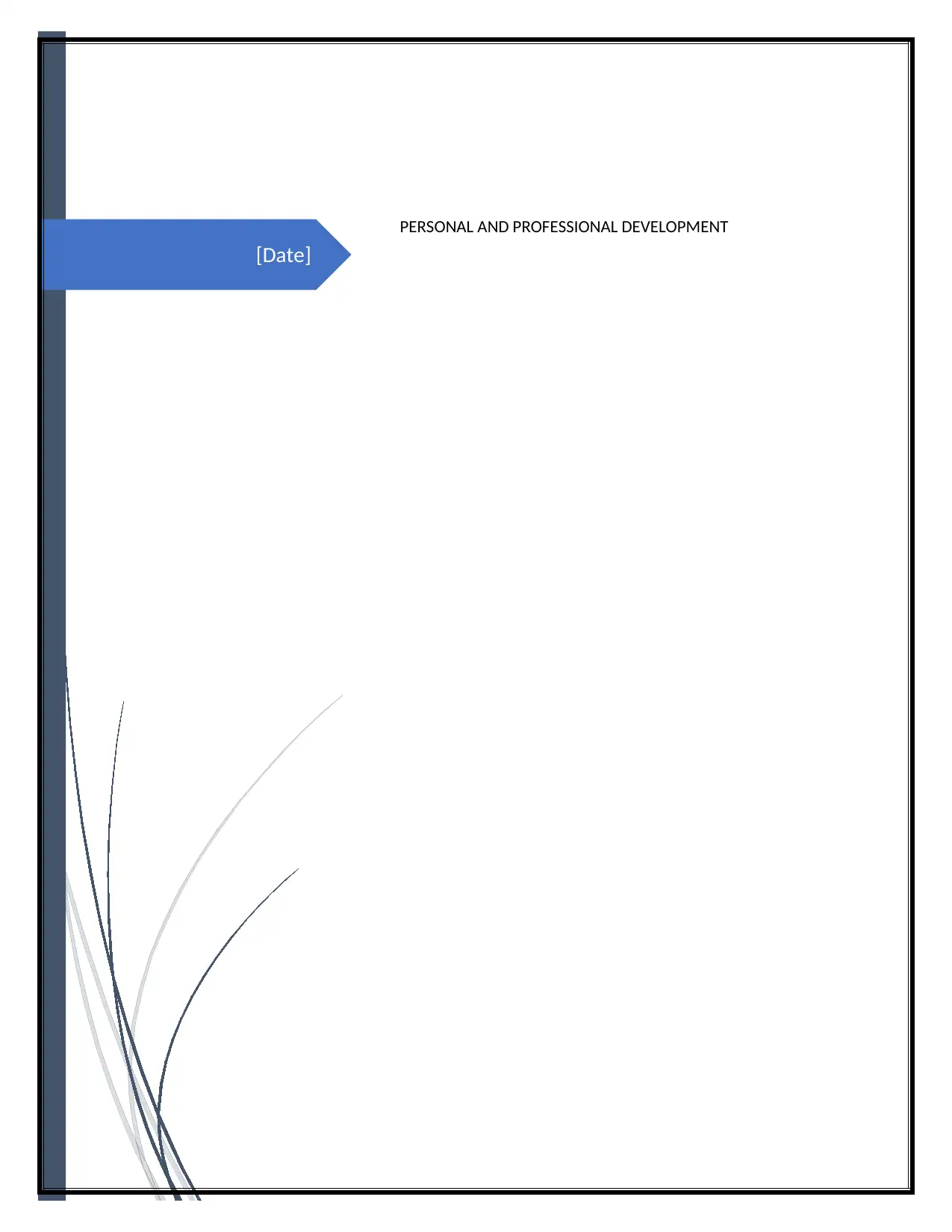
[Date]
PERSONAL AND PROFESSIONAL DEVELOPMENT
PERSONAL AND PROFESSIONAL DEVELOPMENT
Paraphrase This Document
Need a fresh take? Get an instant paraphrase of this document with our AI Paraphraser
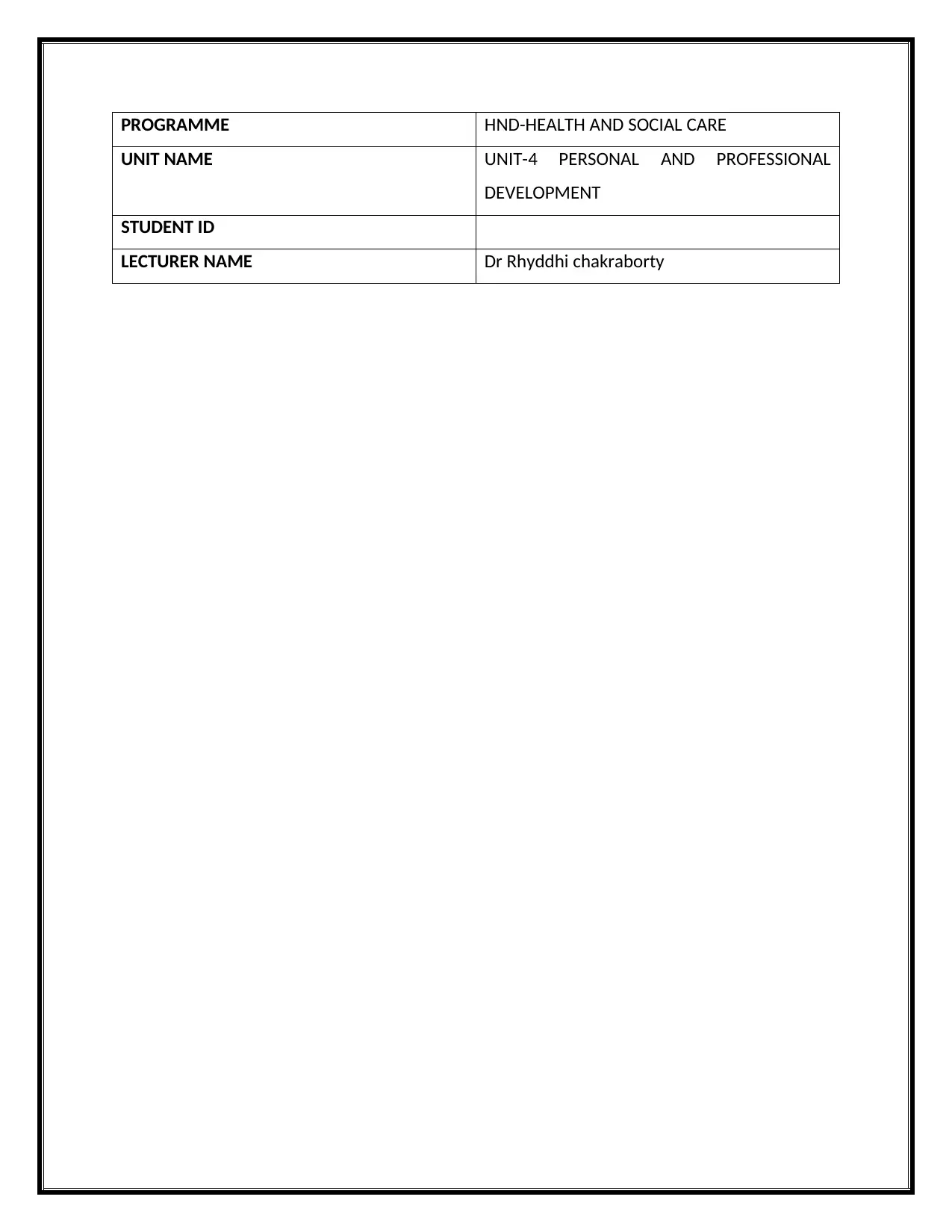
PROGRAMME HND-HEALTH AND SOCIAL CARE
UNIT NAME UNIT-4 PERSONAL AND PROFESSIONAL
DEVELOPMENT
STUDENT ID
LECTURER NAME Dr Rhyddhi chakraborty
UNIT NAME UNIT-4 PERSONAL AND PROFESSIONAL
DEVELOPMENT
STUDENT ID
LECTURER NAME Dr Rhyddhi chakraborty
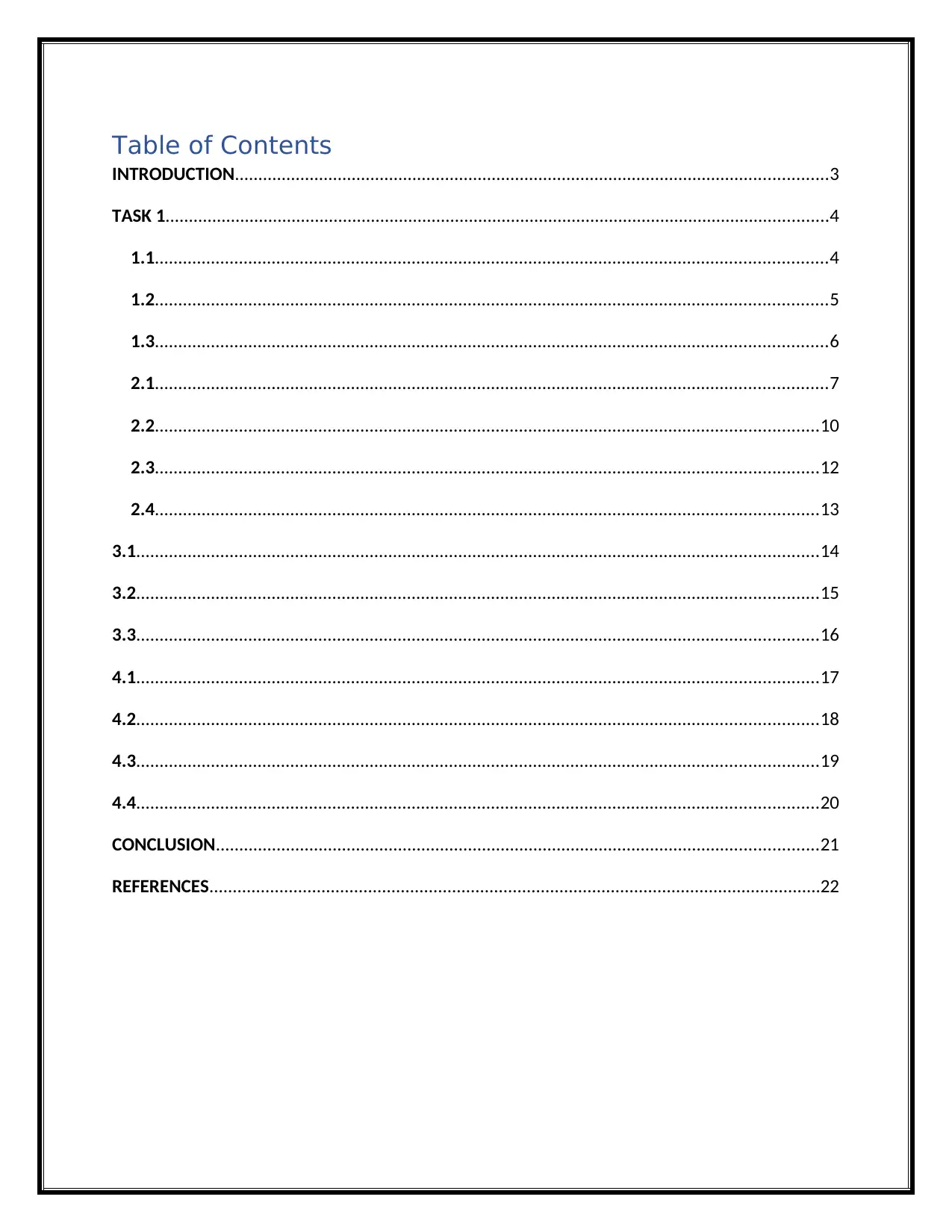
Table of Contents
INTRODUCTION...............................................................................................................................3
TASK 1..............................................................................................................................................4
1.1................................................................................................................................................4
1.2................................................................................................................................................5
1.3................................................................................................................................................6
2.1................................................................................................................................................7
2.2..............................................................................................................................................10
2.3..............................................................................................................................................12
2.4..............................................................................................................................................13
3.1..................................................................................................................................................14
3.2..................................................................................................................................................15
3.3..................................................................................................................................................16
4.1..................................................................................................................................................17
4.2..................................................................................................................................................18
4.3..................................................................................................................................................19
4.4..................................................................................................................................................20
CONCLUSION.................................................................................................................................21
REFERENCES...................................................................................................................................22
INTRODUCTION...............................................................................................................................3
TASK 1..............................................................................................................................................4
1.1................................................................................................................................................4
1.2................................................................................................................................................5
1.3................................................................................................................................................6
2.1................................................................................................................................................7
2.2..............................................................................................................................................10
2.3..............................................................................................................................................12
2.4..............................................................................................................................................13
3.1..................................................................................................................................................14
3.2..................................................................................................................................................15
3.3..................................................................................................................................................16
4.1..................................................................................................................................................17
4.2..................................................................................................................................................18
4.3..................................................................................................................................................19
4.4..................................................................................................................................................20
CONCLUSION.................................................................................................................................21
REFERENCES...................................................................................................................................22
⊘ This is a preview!⊘
Do you want full access?
Subscribe today to unlock all pages.

Trusted by 1+ million students worldwide
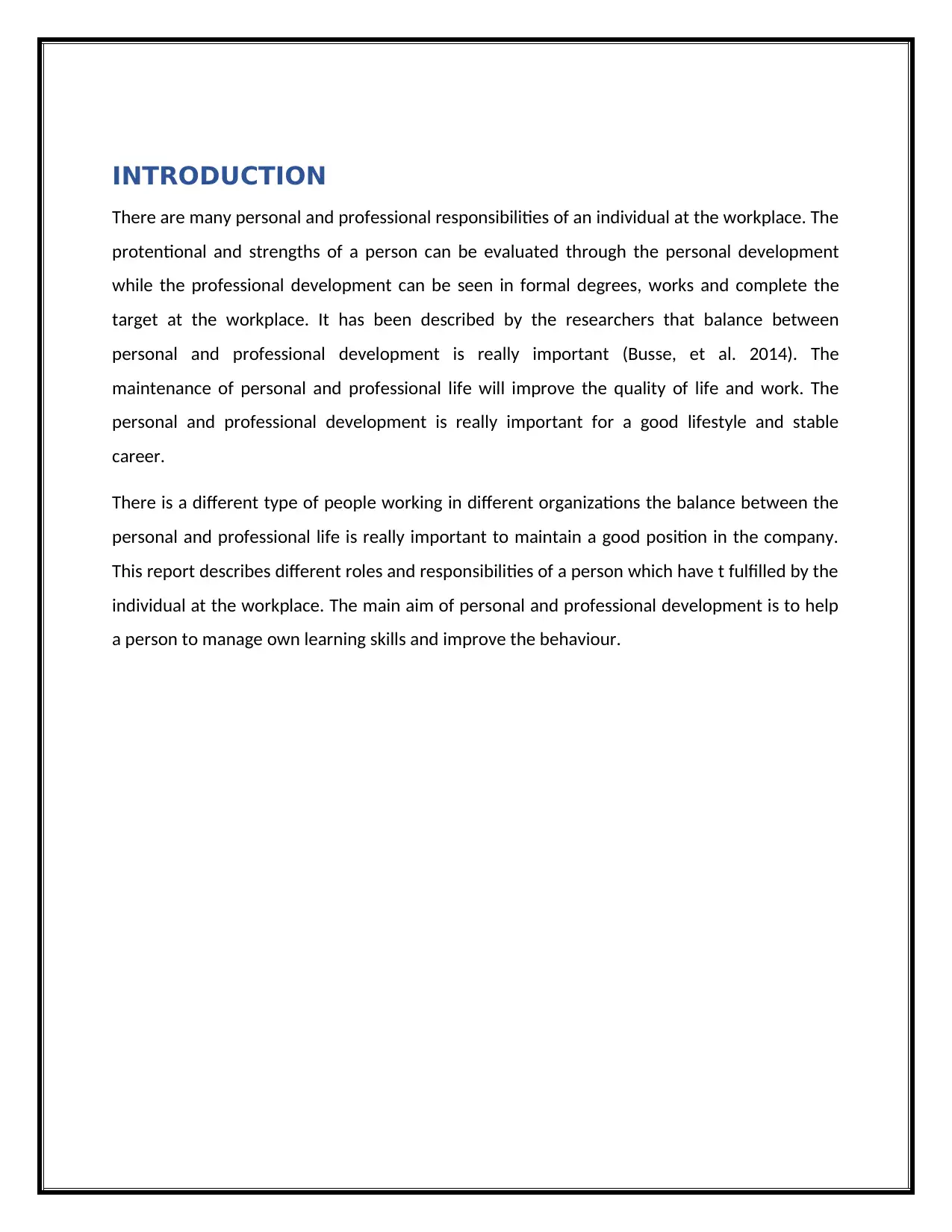
INTRODUCTION
There are many personal and professional responsibilities of an individual at the workplace. The
protentional and strengths of a person can be evaluated through the personal development
while the professional development can be seen in formal degrees, works and complete the
target at the workplace. It has been described by the researchers that balance between
personal and professional development is really important (Busse, et al. 2014). The
maintenance of personal and professional life will improve the quality of life and work. The
personal and professional development is really important for a good lifestyle and stable
career.
There is a different type of people working in different organizations the balance between the
personal and professional life is really important to maintain a good position in the company.
This report describes different roles and responsibilities of a person which have t fulfilled by the
individual at the workplace. The main aim of personal and professional development is to help
a person to manage own learning skills and improve the behaviour.
There are many personal and professional responsibilities of an individual at the workplace. The
protentional and strengths of a person can be evaluated through the personal development
while the professional development can be seen in formal degrees, works and complete the
target at the workplace. It has been described by the researchers that balance between
personal and professional development is really important (Busse, et al. 2014). The
maintenance of personal and professional life will improve the quality of life and work. The
personal and professional development is really important for a good lifestyle and stable
career.
There is a different type of people working in different organizations the balance between the
personal and professional life is really important to maintain a good position in the company.
This report describes different roles and responsibilities of a person which have t fulfilled by the
individual at the workplace. The main aim of personal and professional development is to help
a person to manage own learning skills and improve the behaviour.
Paraphrase This Document
Need a fresh take? Get an instant paraphrase of this document with our AI Paraphraser
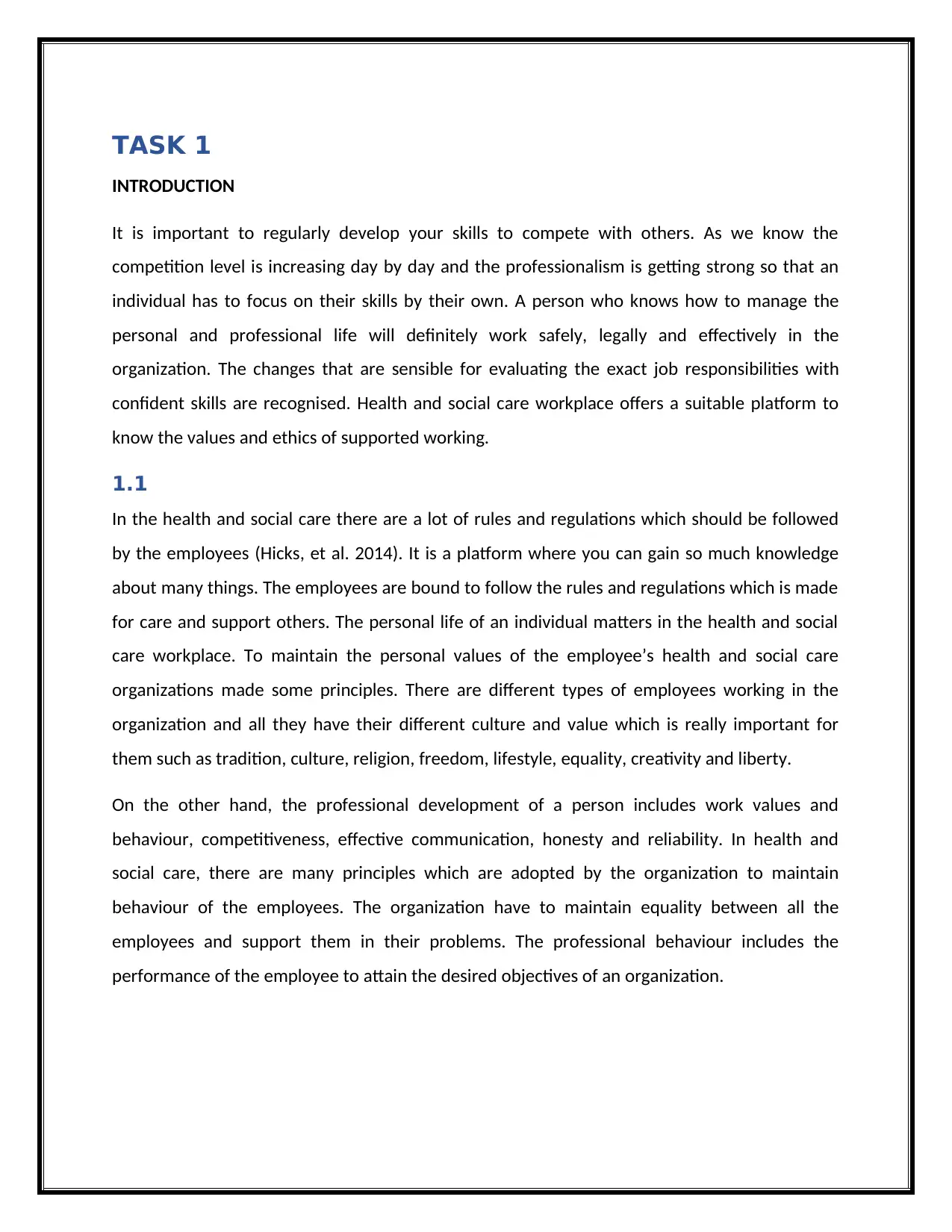
TASK 1
INTRODUCTION
It is important to regularly develop your skills to compete with others. As we know the
competition level is increasing day by day and the professionalism is getting strong so that an
individual has to focus on their skills by their own. A person who knows how to manage the
personal and professional life will definitely work safely, legally and effectively in the
organization. The changes that are sensible for evaluating the exact job responsibilities with
confident skills are recognised. Health and social care workplace offers a suitable platform to
know the values and ethics of supported working.
1.1
In the health and social care there are a lot of rules and regulations which should be followed
by the employees (Hicks, et al. 2014). It is a platform where you can gain so much knowledge
about many things. The employees are bound to follow the rules and regulations which is made
for care and support others. The personal life of an individual matters in the health and social
care workplace. To maintain the personal values of the employee’s health and social care
organizations made some principles. There are different types of employees working in the
organization and all they have their different culture and value which is really important for
them such as tradition, culture, religion, freedom, lifestyle, equality, creativity and liberty.
On the other hand, the professional development of a person includes work values and
behaviour, competitiveness, effective communication, honesty and reliability. In health and
social care, there are many principles which are adopted by the organization to maintain
behaviour of the employees. The organization have to maintain equality between all the
employees and support them in their problems. The professional behaviour includes the
performance of the employee to attain the desired objectives of an organization.
INTRODUCTION
It is important to regularly develop your skills to compete with others. As we know the
competition level is increasing day by day and the professionalism is getting strong so that an
individual has to focus on their skills by their own. A person who knows how to manage the
personal and professional life will definitely work safely, legally and effectively in the
organization. The changes that are sensible for evaluating the exact job responsibilities with
confident skills are recognised. Health and social care workplace offers a suitable platform to
know the values and ethics of supported working.
1.1
In the health and social care there are a lot of rules and regulations which should be followed
by the employees (Hicks, et al. 2014). It is a platform where you can gain so much knowledge
about many things. The employees are bound to follow the rules and regulations which is made
for care and support others. The personal life of an individual matters in the health and social
care workplace. To maintain the personal values of the employee’s health and social care
organizations made some principles. There are different types of employees working in the
organization and all they have their different culture and value which is really important for
them such as tradition, culture, religion, freedom, lifestyle, equality, creativity and liberty.
On the other hand, the professional development of a person includes work values and
behaviour, competitiveness, effective communication, honesty and reliability. In health and
social care, there are many principles which are adopted by the organization to maintain
behaviour of the employees. The organization have to maintain equality between all the
employees and support them in their problems. The professional behaviour includes the
performance of the employee to attain the desired objectives of an organization.
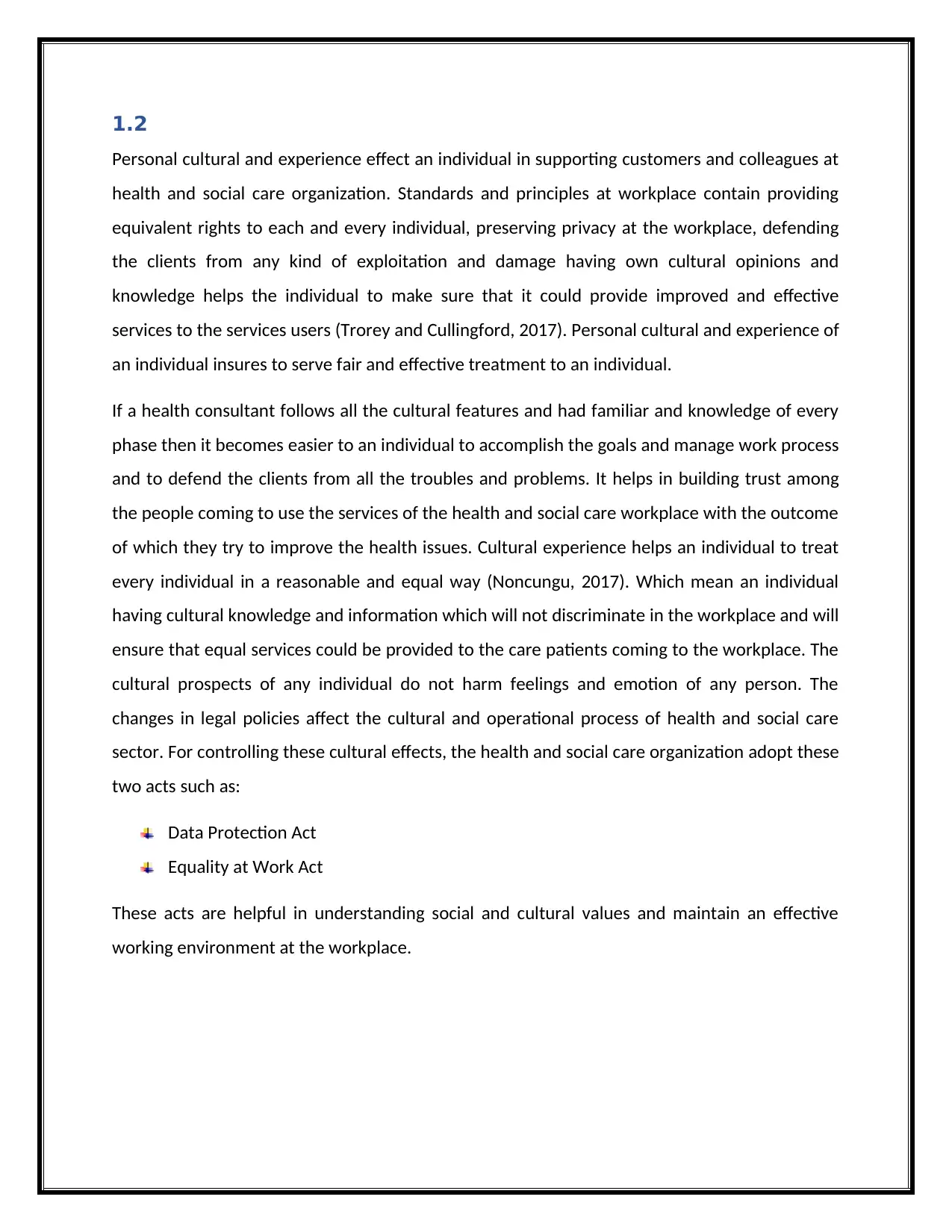
1.2
Personal cultural and experience effect an individual in supporting customers and colleagues at
health and social care organization. Standards and principles at workplace contain providing
equivalent rights to each and every individual, preserving privacy at the workplace, defending
the clients from any kind of exploitation and damage having own cultural opinions and
knowledge helps the individual to make sure that it could provide improved and effective
services to the services users (Trorey and Cullingford, 2017). Personal cultural and experience of
an individual insures to serve fair and effective treatment to an individual.
If a health consultant follows all the cultural features and had familiar and knowledge of every
phase then it becomes easier to an individual to accomplish the goals and manage work process
and to defend the clients from all the troubles and problems. It helps in building trust among
the people coming to use the services of the health and social care workplace with the outcome
of which they try to improve the health issues. Cultural experience helps an individual to treat
every individual in a reasonable and equal way (Noncungu, 2017). Which mean an individual
having cultural knowledge and information which will not discriminate in the workplace and will
ensure that equal services could be provided to the care patients coming to the workplace. The
cultural prospects of any individual do not harm feelings and emotion of any person. The
changes in legal policies affect the cultural and operational process of health and social care
sector. For controlling these cultural effects, the health and social care organization adopt these
two acts such as:
Data Protection Act
Equality at Work Act
These acts are helpful in understanding social and cultural values and maintain an effective
working environment at the workplace.
Personal cultural and experience effect an individual in supporting customers and colleagues at
health and social care organization. Standards and principles at workplace contain providing
equivalent rights to each and every individual, preserving privacy at the workplace, defending
the clients from any kind of exploitation and damage having own cultural opinions and
knowledge helps the individual to make sure that it could provide improved and effective
services to the services users (Trorey and Cullingford, 2017). Personal cultural and experience of
an individual insures to serve fair and effective treatment to an individual.
If a health consultant follows all the cultural features and had familiar and knowledge of every
phase then it becomes easier to an individual to accomplish the goals and manage work process
and to defend the clients from all the troubles and problems. It helps in building trust among
the people coming to use the services of the health and social care workplace with the outcome
of which they try to improve the health issues. Cultural experience helps an individual to treat
every individual in a reasonable and equal way (Noncungu, 2017). Which mean an individual
having cultural knowledge and information which will not discriminate in the workplace and will
ensure that equal services could be provided to the care patients coming to the workplace. The
cultural prospects of any individual do not harm feelings and emotion of any person. The
changes in legal policies affect the cultural and operational process of health and social care
sector. For controlling these cultural effects, the health and social care organization adopt these
two acts such as:
Data Protection Act
Equality at Work Act
These acts are helpful in understanding social and cultural values and maintain an effective
working environment at the workplace.
⊘ This is a preview!⊘
Do you want full access?
Subscribe today to unlock all pages.

Trusted by 1+ million students worldwide
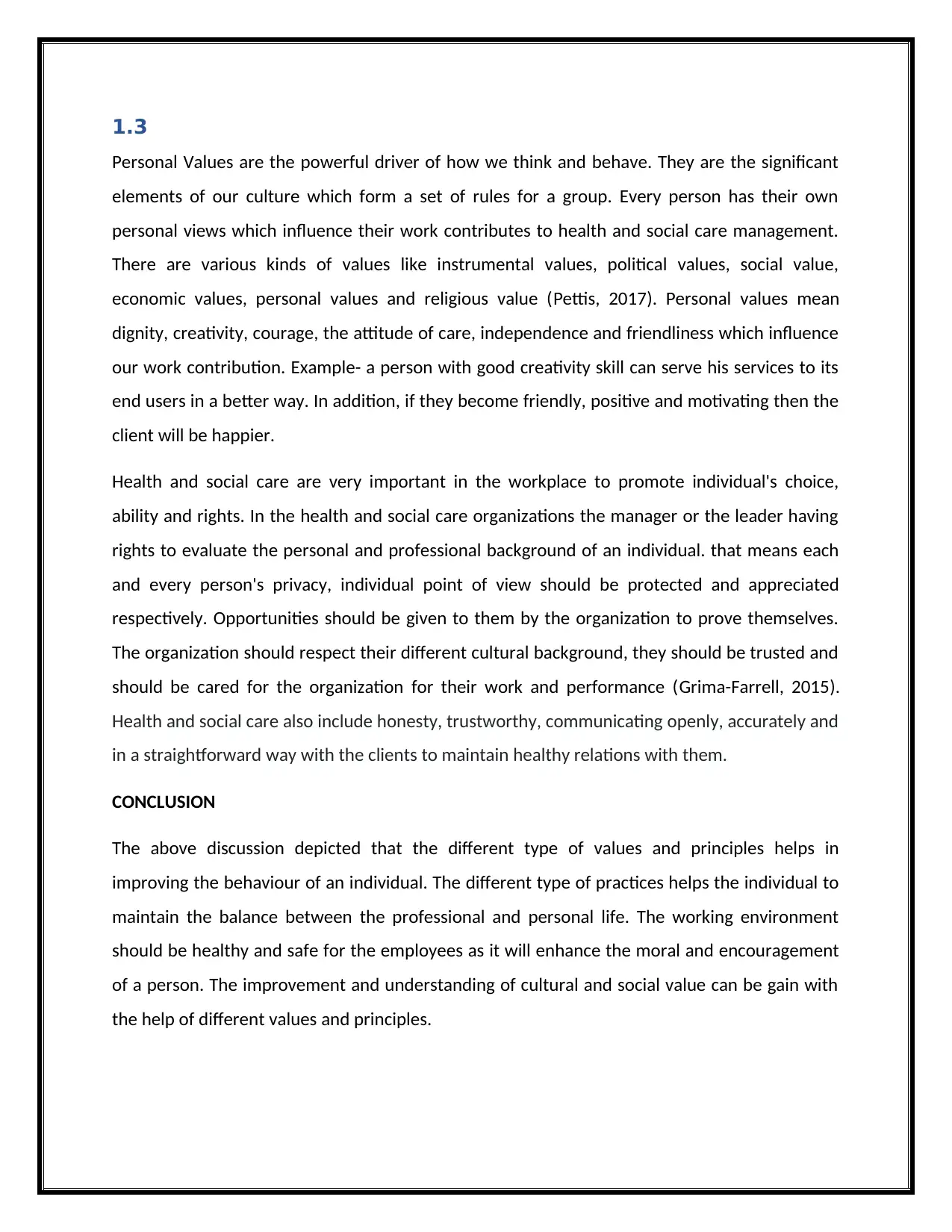
1.3
Personal Values are the powerful driver of how we think and behave. They are the significant
elements of our culture which form a set of rules for a group. Every person has their own
personal views which influence their work contributes to health and social care management.
There are various kinds of values like instrumental values, political values, social value,
economic values, personal values and religious value (Pettis, 2017). Personal values mean
dignity, creativity, courage, the attitude of care, independence and friendliness which influence
our work contribution. Example- a person with good creativity skill can serve his services to its
end users in a better way. In addition, if they become friendly, positive and motivating then the
client will be happier.
Health and social care are very important in the workplace to promote individual's choice,
ability and rights. In the health and social care organizations the manager or the leader having
rights to evaluate the personal and professional background of an individual. that means each
and every person's privacy, individual point of view should be protected and appreciated
respectively. Opportunities should be given to them by the organization to prove themselves.
The organization should respect their different cultural background, they should be trusted and
should be cared for the organization for their work and performance (Grima-Farrell, 2015).
Health and social care also include honesty, trustworthy, communicating openly, accurately and
in a straightforward way with the clients to maintain healthy relations with them.
CONCLUSION
The above discussion depicted that the different type of values and principles helps in
improving the behaviour of an individual. The different type of practices helps the individual to
maintain the balance between the professional and personal life. The working environment
should be healthy and safe for the employees as it will enhance the moral and encouragement
of a person. The improvement and understanding of cultural and social value can be gain with
the help of different values and principles.
Personal Values are the powerful driver of how we think and behave. They are the significant
elements of our culture which form a set of rules for a group. Every person has their own
personal views which influence their work contributes to health and social care management.
There are various kinds of values like instrumental values, political values, social value,
economic values, personal values and religious value (Pettis, 2017). Personal values mean
dignity, creativity, courage, the attitude of care, independence and friendliness which influence
our work contribution. Example- a person with good creativity skill can serve his services to its
end users in a better way. In addition, if they become friendly, positive and motivating then the
client will be happier.
Health and social care are very important in the workplace to promote individual's choice,
ability and rights. In the health and social care organizations the manager or the leader having
rights to evaluate the personal and professional background of an individual. that means each
and every person's privacy, individual point of view should be protected and appreciated
respectively. Opportunities should be given to them by the organization to prove themselves.
The organization should respect their different cultural background, they should be trusted and
should be cared for the organization for their work and performance (Grima-Farrell, 2015).
Health and social care also include honesty, trustworthy, communicating openly, accurately and
in a straightforward way with the clients to maintain healthy relations with them.
CONCLUSION
The above discussion depicted that the different type of values and principles helps in
improving the behaviour of an individual. The different type of practices helps the individual to
maintain the balance between the professional and personal life. The working environment
should be healthy and safe for the employees as it will enhance the moral and encouragement
of a person. The improvement and understanding of cultural and social value can be gain with
the help of different values and principles.
Paraphrase This Document
Need a fresh take? Get an instant paraphrase of this document with our AI Paraphraser
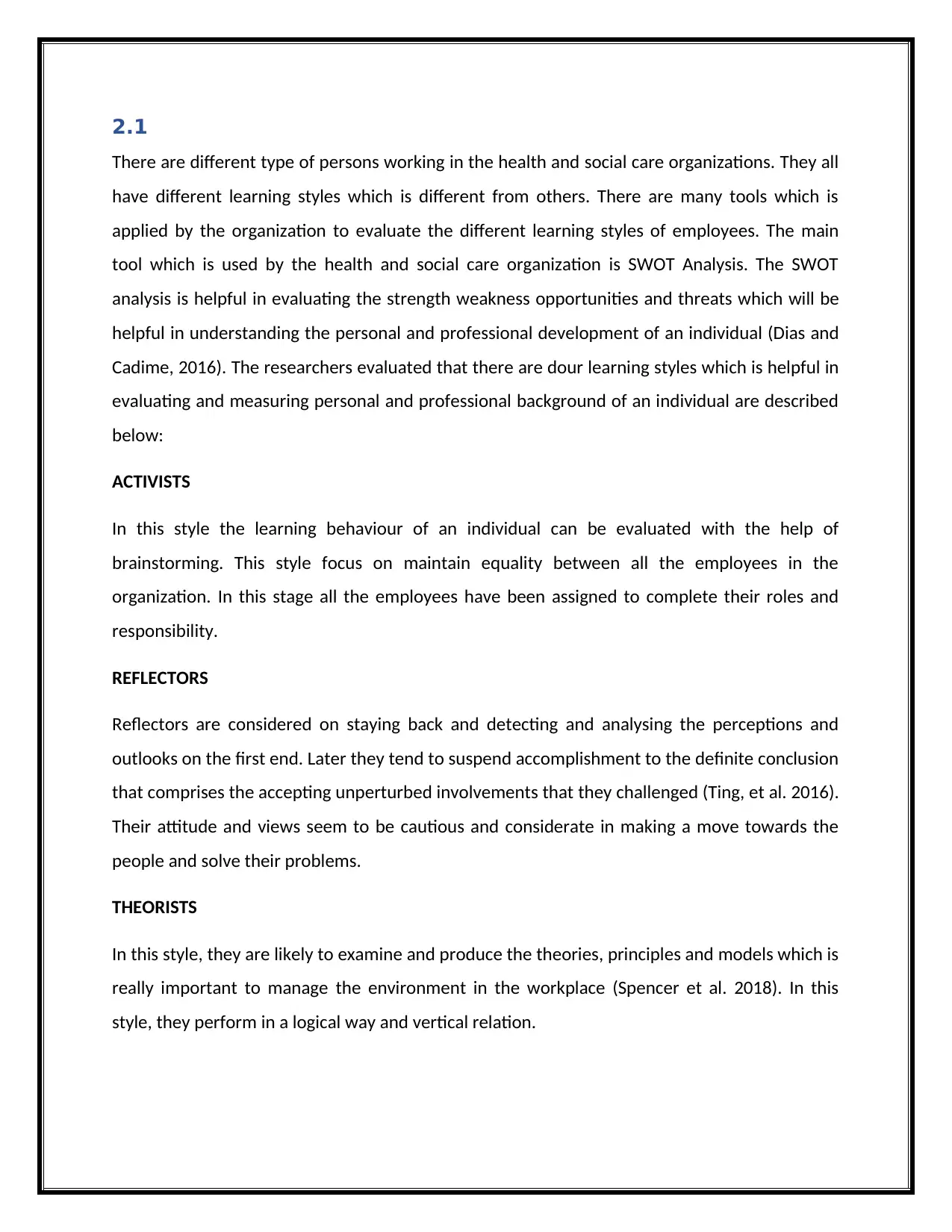
2.1
There are different type of persons working in the health and social care organizations. They all
have different learning styles which is different from others. There are many tools which is
applied by the organization to evaluate the different learning styles of employees. The main
tool which is used by the health and social care organization is SWOT Analysis. The SWOT
analysis is helpful in evaluating the strength weakness opportunities and threats which will be
helpful in understanding the personal and professional development of an individual (Dias and
Cadime, 2016). The researchers evaluated that there are dour learning styles which is helpful in
evaluating and measuring personal and professional background of an individual are described
below:
ACTIVISTS
In this style the learning behaviour of an individual can be evaluated with the help of
brainstorming. This style focus on maintain equality between all the employees in the
organization. In this stage all the employees have been assigned to complete their roles and
responsibility.
REFLECTORS
Reflectors are considered on staying back and detecting and analysing the perceptions and
outlooks on the first end. Later they tend to suspend accomplishment to the definite conclusion
that comprises the accepting unperturbed involvements that they challenged (Ting, et al. 2016).
Their attitude and views seem to be cautious and considerate in making a move towards the
people and solve their problems.
THEORISTS
In this style, they are likely to examine and produce the theories, principles and models which is
really important to manage the environment in the workplace (Spencer et al. 2018). In this
style, they perform in a logical way and vertical relation.
There are different type of persons working in the health and social care organizations. They all
have different learning styles which is different from others. There are many tools which is
applied by the organization to evaluate the different learning styles of employees. The main
tool which is used by the health and social care organization is SWOT Analysis. The SWOT
analysis is helpful in evaluating the strength weakness opportunities and threats which will be
helpful in understanding the personal and professional development of an individual (Dias and
Cadime, 2016). The researchers evaluated that there are dour learning styles which is helpful in
evaluating and measuring personal and professional background of an individual are described
below:
ACTIVISTS
In this style the learning behaviour of an individual can be evaluated with the help of
brainstorming. This style focus on maintain equality between all the employees in the
organization. In this stage all the employees have been assigned to complete their roles and
responsibility.
REFLECTORS
Reflectors are considered on staying back and detecting and analysing the perceptions and
outlooks on the first end. Later they tend to suspend accomplishment to the definite conclusion
that comprises the accepting unperturbed involvements that they challenged (Ting, et al. 2016).
Their attitude and views seem to be cautious and considerate in making a move towards the
people and solve their problems.
THEORISTS
In this style, they are likely to examine and produce the theories, principles and models which is
really important to manage the environment in the workplace (Spencer et al. 2018). In this
style, they perform in a logical way and vertical relation.
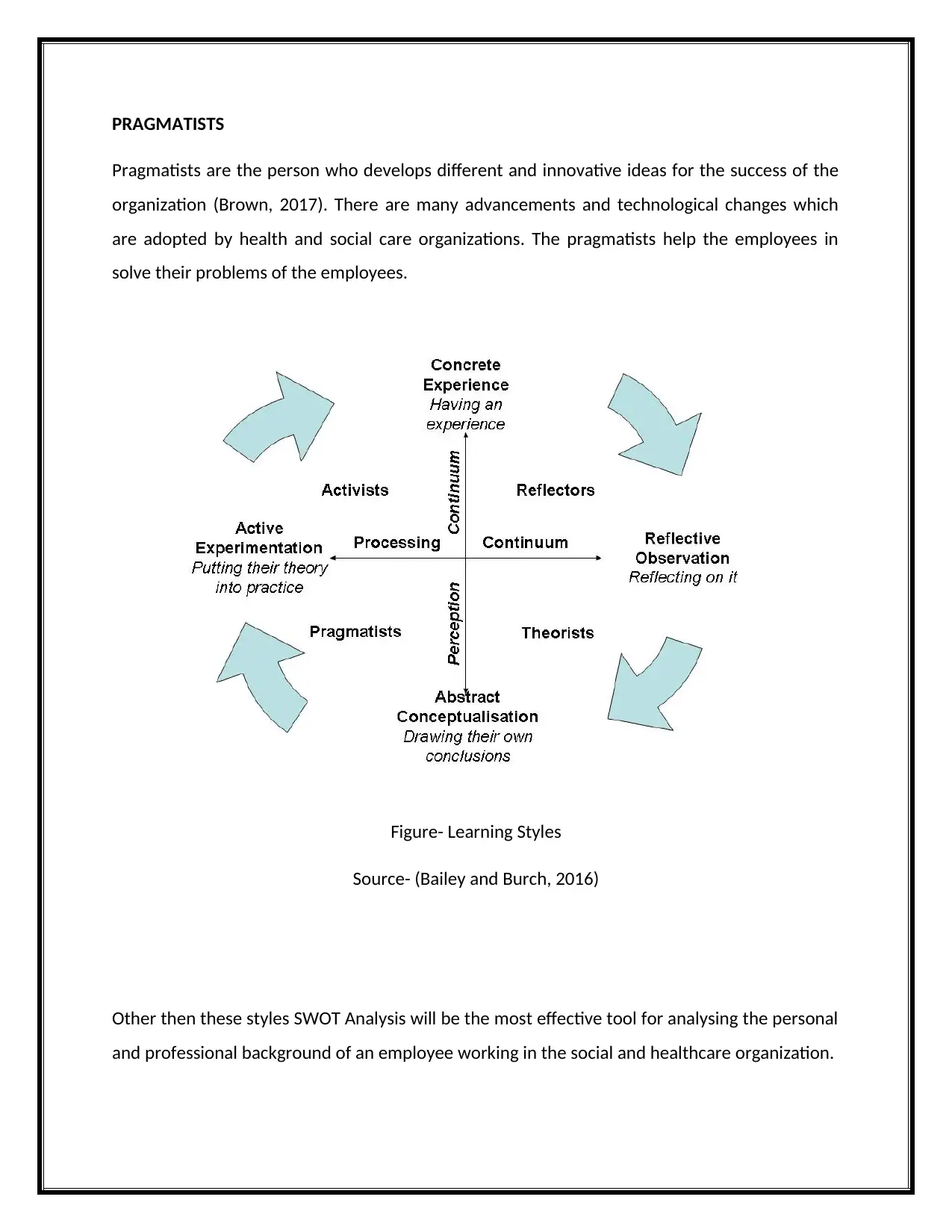
PRAGMATISTS
Pragmatists are the person who develops different and innovative ideas for the success of the
organization (Brown, 2017). There are many advancements and technological changes which
are adopted by health and social care organizations. The pragmatists help the employees in
solve their problems of the employees.
Figure- Learning Styles
Source- (Bailey and Burch, 2016)
Other then these styles SWOT Analysis will be the most effective tool for analysing the personal
and professional background of an employee working in the social and healthcare organization.
Pragmatists are the person who develops different and innovative ideas for the success of the
organization (Brown, 2017). There are many advancements and technological changes which
are adopted by health and social care organizations. The pragmatists help the employees in
solve their problems of the employees.
Figure- Learning Styles
Source- (Bailey and Burch, 2016)
Other then these styles SWOT Analysis will be the most effective tool for analysing the personal
and professional background of an employee working in the social and healthcare organization.
⊘ This is a preview!⊘
Do you want full access?
Subscribe today to unlock all pages.

Trusted by 1+ million students worldwide
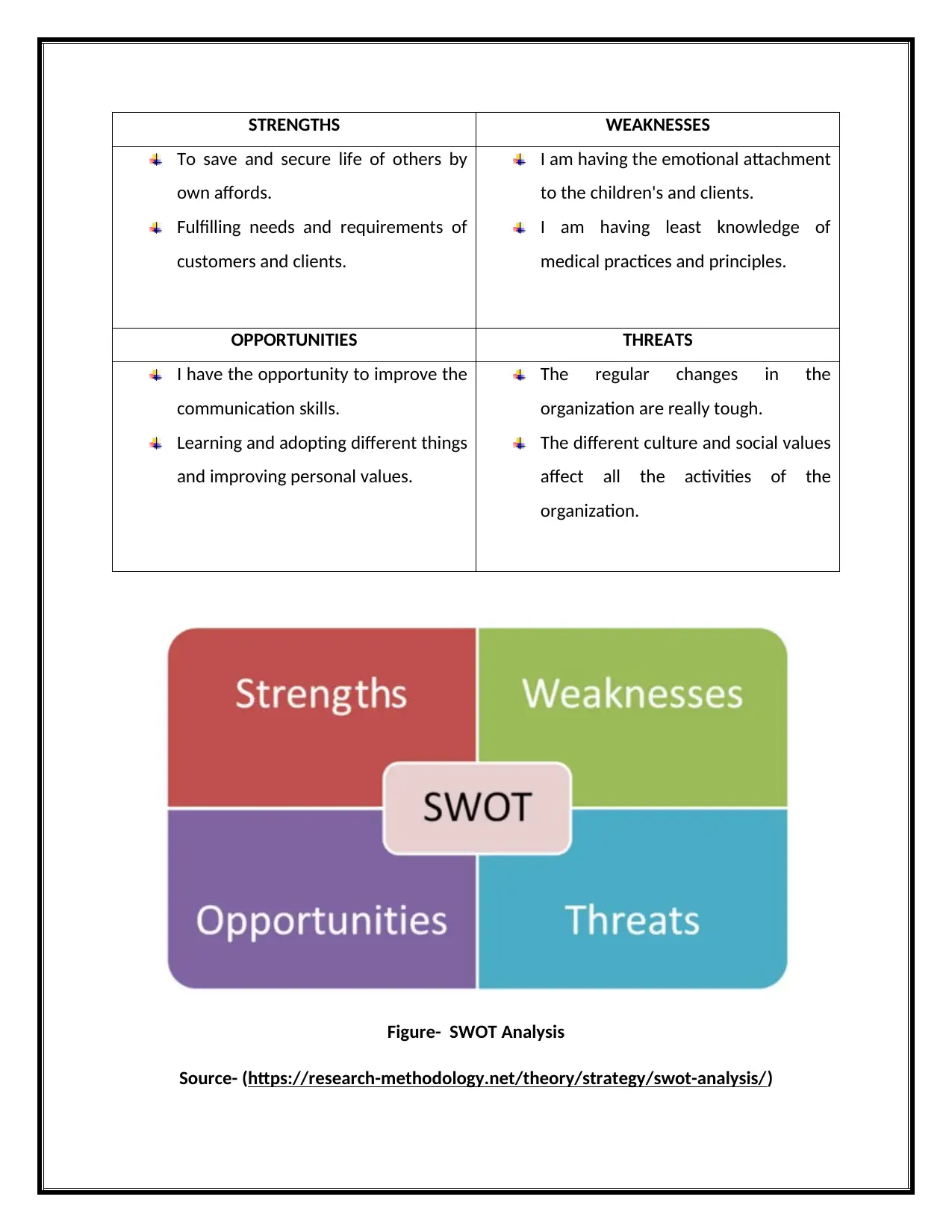
STRENGTHS WEAKNESSES
To save and secure life of others by
own affords.
Fulfilling needs and requirements of
customers and clients.
I am having the emotional attachment
to the children's and clients.
I am having least knowledge of
medical practices and principles.
OPPORTUNITIES THREATS
I have the opportunity to improve the
communication skills.
Learning and adopting different things
and improving personal values.
The regular changes in the
organization are really tough.
The different culture and social values
affect all the activities of the
organization.
Figure- SWOT Analysis
Source- (https://research-methodology.net/theory/strategy/swot-analysis/)
To save and secure life of others by
own affords.
Fulfilling needs and requirements of
customers and clients.
I am having the emotional attachment
to the children's and clients.
I am having least knowledge of
medical practices and principles.
OPPORTUNITIES THREATS
I have the opportunity to improve the
communication skills.
Learning and adopting different things
and improving personal values.
The regular changes in the
organization are really tough.
The different culture and social values
affect all the activities of the
organization.
Figure- SWOT Analysis
Source- (https://research-methodology.net/theory/strategy/swot-analysis/)
Paraphrase This Document
Need a fresh take? Get an instant paraphrase of this document with our AI Paraphraser
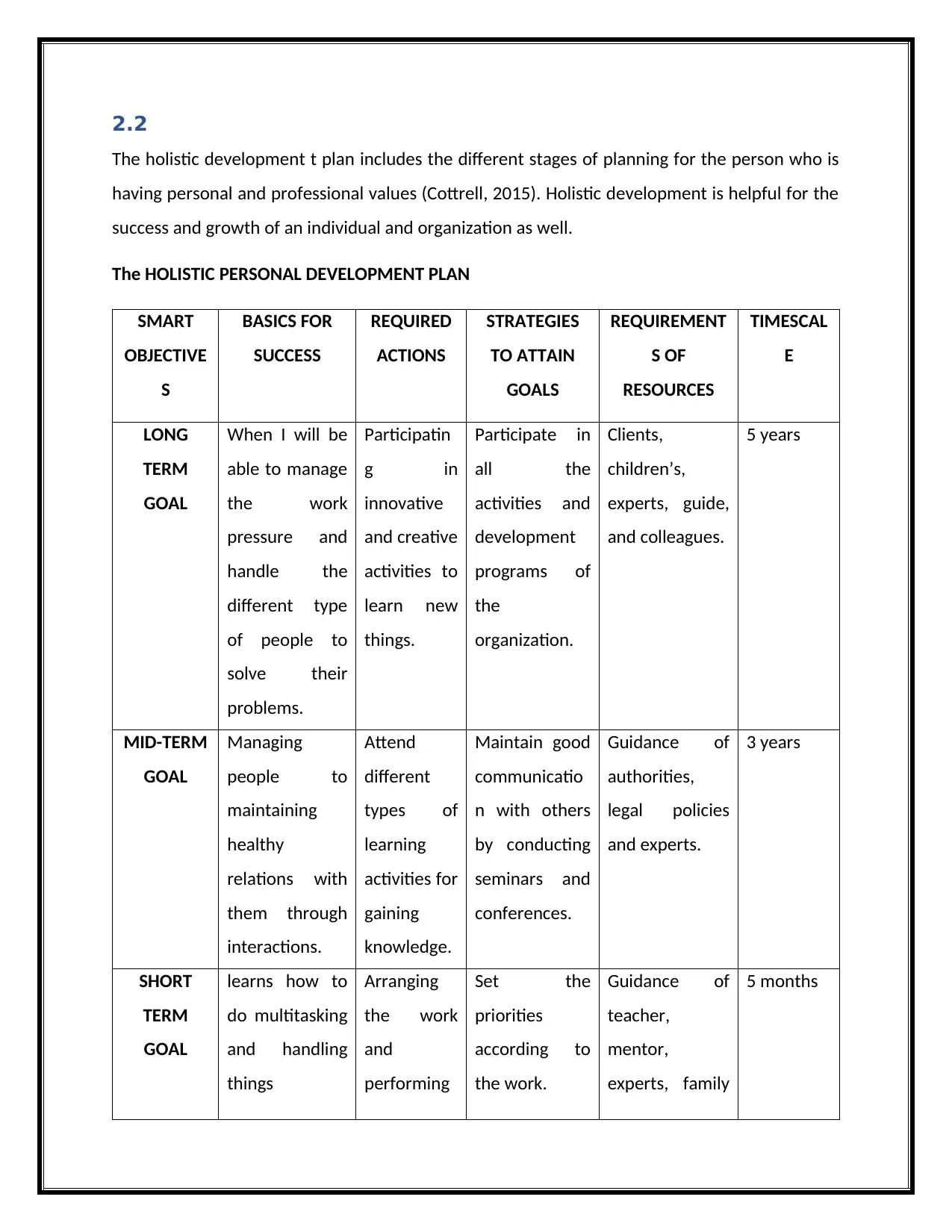
2.2
The holistic development t plan includes the different stages of planning for the person who is
having personal and professional values (Cottrell, 2015). Holistic development is helpful for the
success and growth of an individual and organization as well.
The HOLISTIC PERSONAL DEVELOPMENT PLAN
SMART
OBJECTIVE
S
BASICS FOR
SUCCESS
REQUIRED
ACTIONS
STRATEGIES
TO ATTAIN
GOALS
REQUIREMENT
S OF
RESOURCES
TIMESCAL
E
LONG
TERM
GOAL
When I will be
able to manage
the work
pressure and
handle the
different type
of people to
solve their
problems.
Participatin
g in
innovative
and creative
activities to
learn new
things.
Participate in
all the
activities and
development
programs of
the
organization.
Clients,
children’s,
experts, guide,
and colleagues.
5 years
MID-TERM
GOAL
Managing
people to
maintaining
healthy
relations with
them through
interactions.
Attend
different
types of
learning
activities for
gaining
knowledge.
Maintain good
communicatio
n with others
by conducting
seminars and
conferences.
Guidance of
authorities,
legal policies
and experts.
3 years
SHORT
TERM
GOAL
learns how to
do multitasking
and handling
things
Arranging
the work
and
performing
Set the
priorities
according to
the work.
Guidance of
teacher,
mentor,
experts, family
5 months
The holistic development t plan includes the different stages of planning for the person who is
having personal and professional values (Cottrell, 2015). Holistic development is helpful for the
success and growth of an individual and organization as well.
The HOLISTIC PERSONAL DEVELOPMENT PLAN
SMART
OBJECTIVE
S
BASICS FOR
SUCCESS
REQUIRED
ACTIONS
STRATEGIES
TO ATTAIN
GOALS
REQUIREMENT
S OF
RESOURCES
TIMESCAL
E
LONG
TERM
GOAL
When I will be
able to manage
the work
pressure and
handle the
different type
of people to
solve their
problems.
Participatin
g in
innovative
and creative
activities to
learn new
things.
Participate in
all the
activities and
development
programs of
the
organization.
Clients,
children’s,
experts, guide,
and colleagues.
5 years
MID-TERM
GOAL
Managing
people to
maintaining
healthy
relations with
them through
interactions.
Attend
different
types of
learning
activities for
gaining
knowledge.
Maintain good
communicatio
n with others
by conducting
seminars and
conferences.
Guidance of
authorities,
legal policies
and experts.
3 years
SHORT
TERM
GOAL
learns how to
do multitasking
and handling
things
Arranging
the work
and
performing
Set the
priorities
according to
the work.
Guidance of
teacher,
mentor,
experts, family
5 months
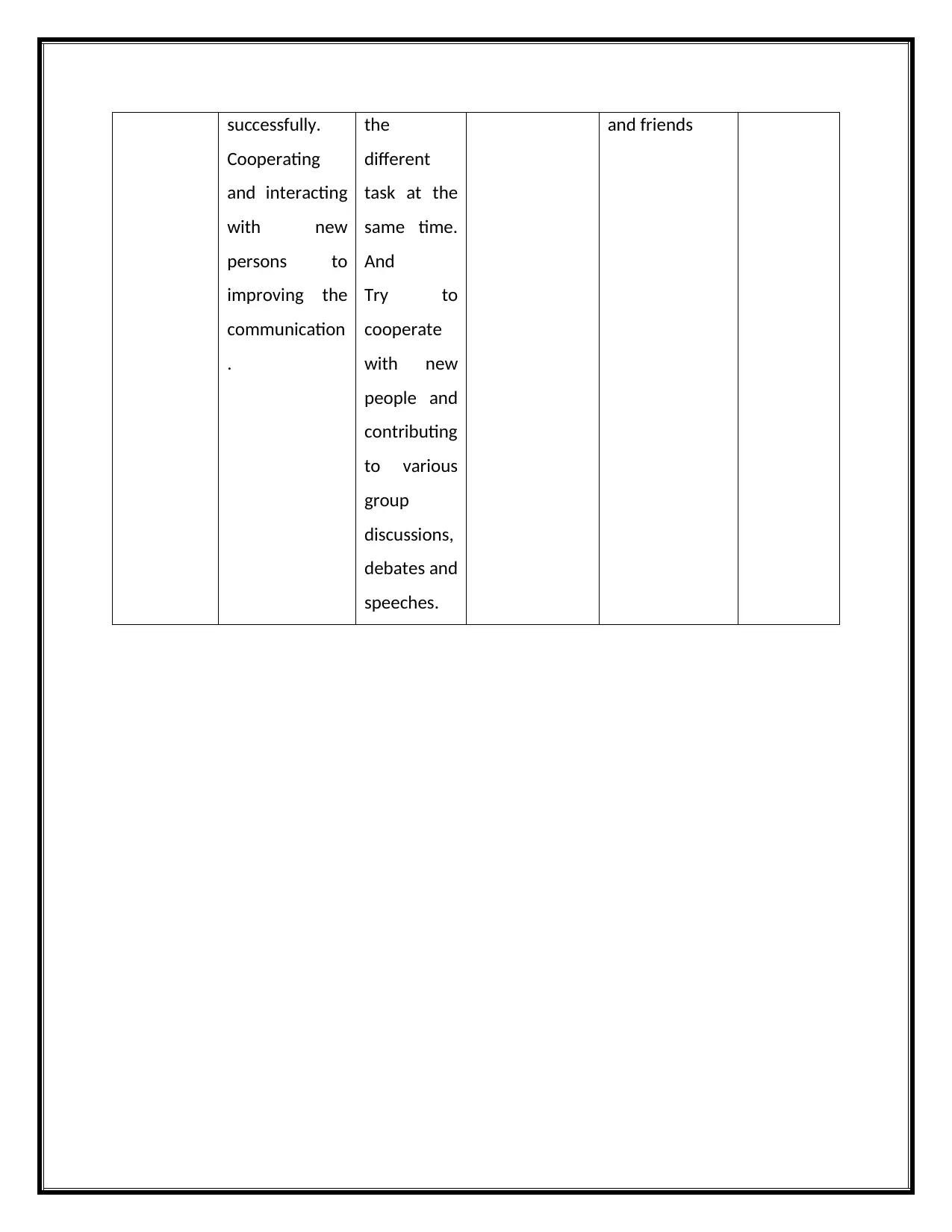
successfully.
Cooperating
and interacting
with new
persons to
improving the
communication
.
the
different
task at the
same time.
And
Try to
cooperate
with new
people and
contributing
to various
group
discussions,
debates and
speeches.
and friends
Cooperating
and interacting
with new
persons to
improving the
communication
.
the
different
task at the
same time.
And
Try to
cooperate
with new
people and
contributing
to various
group
discussions,
debates and
speeches.
and friends
⊘ This is a preview!⊘
Do you want full access?
Subscribe today to unlock all pages.

Trusted by 1+ million students worldwide
1 out of 24
Related Documents
Your All-in-One AI-Powered Toolkit for Academic Success.
+13062052269
info@desklib.com
Available 24*7 on WhatsApp / Email
![[object Object]](/_next/static/media/star-bottom.7253800d.svg)
Unlock your academic potential
Copyright © 2020–2025 A2Z Services. All Rights Reserved. Developed and managed by ZUCOL.





